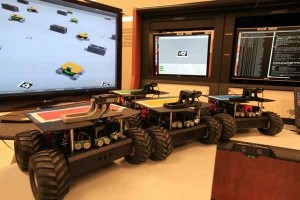
NASA is challenging college students to develop swarming robots capable of searching for resources on another planet.
The space agency selected California State University, Los Angeles and Pasadena City College to compete against each other and 10 other colleges nationwide to program robots to mimic the behavior of ants sent out to find food or water.
It’s part of NASA’s inaugural Swarmathon Challenge, a competition for students from minority serving universities and community colleges that’s funded by NASA to enhance its robotics research.
PCC and Cal State LA will receive three robots called “Swarmies” to test software for a physical competition to be held at Kennedy Space Center in April. Across the country, 23 other schools will compete separately in virtual competition that uses simulations.
“The competition is to try to find the most resources, using swarm technology, which models how ants behave,” said Nancy Warter-Perez, a professor in electrical and computer engineering at Cal State LA. “Once one of them finds something, they can communicate with the others and then collect the resources more efficiently.”
NASA expects the technology to assist human missions on the Moon or Mars, with the robots scouring the surface while astronauts focus on research. The space agency partnered with the University of New Mexico to develop the Swarmathon.
The team that collects the most resources during the competition wins a $5,000 cash prize.
By competing, the students from the 12 schools also get opportunities to apply for research internships, according to NASA. PCC and Cal State LA are the only two schools from California to make it into the physical competition.
The competition doesn’t cover the cost of travel, so the schools will have to fund raise for the trip for Florida. They don’t have to be there to compete, as they’ll upload their algorithms for judging, Warter-Perez said.
Next semester, Warter-Perez will guide a team of 18 through development of the robot’s software, with one group taking the lead and a less experienced team providing support. Students Mabel Luu and Brian Martinez brought the idea of competing to Warter-Perez and helped with the highly competitive application process, she said.
“It’s going to be a huge learning opportunity for our students,” she said.
At Pasadena City College, Computer Science instructor Jamal Ashraf will work with students from four of his classes to program the robots using the Python and C++ coding languages. The challenge, he said, is getting the robots to talk with each other without using a centralized unit to relay messages. The competition’s rules bar humans from communicating with the robots during the competition.
NASA already has its own engineers working on swarming technology, but the competition gives them an opportunity to get a different perspective.
“They are looking for something outside of the box, something they didn’t think about,” Ashraf said.
As part of their arrangement with NASA, PCC and Cal State LA will keep the test robots to inspire youths. According to Warter-Perez, the two colleges are expected to take the robots to middle and high schools through Los Angeles County to create interest in science, technology, engineering and math.



















